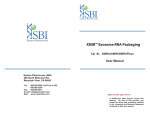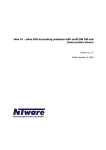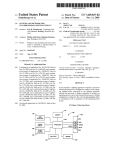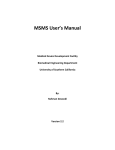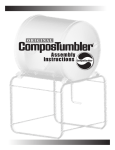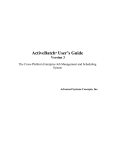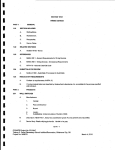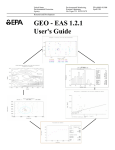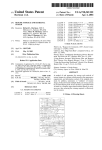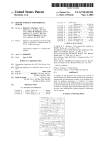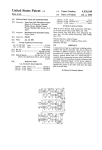Download Winch control system
Transcript
US008909379B2 (12) United States Patent (10) Patent N0.: (45) Date of Patent: Fisher (54) 5,209,560 5,769,527 5,920,476 6,209,852 WINCH CONTROL SYSTEM (75) Inventor: Scott Fisher, Las Vegas, NV (U S) 6,297,610 B1 (73) Assignee: Tait Towers Manufacturing, LLC, LititZ, PA (US) (*) Notice: 6,343,824 B1 * 6,459,919 B1 6,600,289 B2 6,873,355 B1 Subject to any disclaimer, the term of this patent is extended or adjusted under 35 U.S.C. 154(b) by 476 days. (21) Appl.No.: 13/413,841 (22) Filed: Mar. 7, 2012 (65) 5/1993 6/1998 7/1999 4/2001 Dec. 9, 2014 Taylor et a1. Taylor et a1. Hennessey et al. George et al. 10/2001 Bauer et a1. 2/2002 Foy .......................... .. 294/8235 10/2002 Lys et a1. 7/2003 George et al. 3/2005 Thompson et al. 6,995,682 B1 * 2/2006 7,080,824 B1 7,080,825 B1 7/2006 George et al. 7/2006 George et al. Chen et a1. ............... .. 340/1222 7,556,241 B2* 7/2009 Geagan ....................... .. 254/342 7,789,374 7,671,547 B2 * 9/2010 3/2010 Averill Addleman et al. ............... .. 254/323 7,971,856 B2 7/2011 Kochan 8,768,492 B2 * 2004/0263100 Al * Prior Publication Data US 2013/0238135 A1 A A A B1 US 8,909,379 B2 7/2014 12/2004 Fisher ........................... .. 700/61 Heravi et al. ............... .. 318/280 (Continued) Sep. 12, 2013 FOREIGN PATENT DOCUMENTS (51) Int. Cl. G06F 19/00 (2011.01) B66D 1/60 (2006.01) B66D 1/54 (2006.01) (52) US. Cl. CPC B66D 1/60 (2013.01); B66D 1/54 (2013.01) USPC (58) ........................................... .. 700/275; 472/80 WO WO 2011079115 Al 2011079122 Al 6/2011 6/2011 OTHER PUBLICATIONS XLNT Advanced Technologies Manufacturing BV, User Manual, Cyberhoist CH 1000/500/250 EU/US, Jan. 2009, Version 3, 32 pgs. Field of Classi?cation Search (Continued) CPC .................................. .. B66D 1/60; B66D 1/54 USPC ........................................... .. 472/80; 700/275 Primary Examiner * Michael D Masinick See application ?le for complete search history. (57) (56) References Cited U.S. PATENT DOCUMENTS 3,476,385 A * 11/1969 Foy ............................... .. 472/80 3,675,794 A * 7/1972 Ingramet a1. 4,185,520 A * l/l980 4,392,187 A 7/1983 Bornhorst 4,448,398 A * 4,710,819 A 4,947,302 A 5/1984 414/1383 Henneman et al. ........... .. 475/83 Wyatt .......................... .. 254/361 ABSTRACT A control system is provided for a group of Winches in a system. Each motorized Winch in the system can have a control board that can process and generate control com mands for operation of the Winch. The control board can receive inputs from an automation control system and/or the other control boards to be used in the generation of the control commands for the Winch. 12/1987 Brown 8/1990 Callahan 304 Power \ Supply 20 Claims, 4 Drawing Sheets Automation H contml 8 ‘ Operator System ' ,4 b. 103 US 8,909,379 B2 Page 2 (56) References Cited 2014/0180439 A1* US. PATENT DOCUMENTS 6/2014 Fisher ........................... .. 700/17 OTHER PUBLICATIONS 2007/0191966 A1* 8/2007 Fisher et al‘ ““““““““““ H 700/1 FTSI Automation, F315/F515 Self-Contained Flying Winches, 2 2008/0091280 A1* 4/2008 MayheW ....................... .. 700/22 Pages~ 2009/0015426 A1 2013/0310951 A1* 1/2009 Long et a1. 11/2013 Fisher ............................. .. 700/2 * cited by examiner US. Patent ma M. Dec. 9, 2014 Sheet 1 0f 4 US 8,909,379 B2 US. Patent Dec. 9, 2014 US 8,909,379 B2 Sheet 2 0f 4 103 103 105 105 / 208 210 210 105 105 103 105R 103 A w > 0 \113 \ 200 FIG. 2 US. Patent Dec. 9, 2014 Sheet 3 0f4 Power 304 \ Su 1 pp y US 8,909,379 B2 Automation Control M D System w ....... 4< Operator \ 302 103 FIG. 3 304 \ POW6r Automation Supply Control System M D @ O perd- tor US. Patent 103 Dec. 9, 2014 Sheet 4 0f4 From Powcr To/From Control TO/From To/Frorn External Supply System Winches Devices \ l»- 306 I,’ 1 15 l—l i 303 'l‘ l—l Control ‘ Section ‘ l . Control/Processing Board Power C 0 ntr01 410 / US 8,909,379 B2 . , , Microproccssor M _2 c Memory Device Motor ? Section Cable Section FIG. 5 % US 8,909,379 B2 1 2 WINCH CONTROL SYSTEM board includes a microprocessor and a memory device. The memory device stores a computer program executable by the microprocessor to generate a plurality of commands to con trol operation of the winch. The control board of a ?rst winch BACKGROUND The application generally relates to winch operation and of the plurality of winches is operable to generate the plurality control. The application relates more speci?cally to a system for controlling a plurality of motorized winches using a dis tributed control model wherein each winch can process and generate its own control instructions or motion pro?les and of commands to control operation of a second winch of the plurality of winches in response to the failure of the control board of the second winch of the plurality of winches. The present application is also directed to a winch. The can provide safety and system monitoring. One use of motorized winches is to suspend and move winch includes a motor, a cable reel connected to the motor and a cable. The cable is stored on or released from the cable objects, equipment and/ or persons above the ground to reel in response to the motor rotating the cable reel. The winch enhance live performances, such as sporting events or theat rical/religious performances, or to increase the realism of movie or television productions. For example, several motor also includes a control board. The control board has a micro processor and a memory device. The memory device stores a ized winches could be used to suspend and move a person or erate a plurality of commands to control operation of the motor. In one embodiment, the control board can operate the winch as a standalone device, i.e., independent of an automa computer algorithm executable by the microprocessor to gen object in the air during a theatrical performance to give the appearance that the person or object is “?ying” through the air. In another example, a camera could be suspended over the playing surface of a sporting event to capture a different tion control system. However, in another embodiment, the 20 winches in the system have to work in a coordinated manner to avoid injury to the person or damage to the object or equipment being suspended. A mistimed or improper action control board can operate the winch as a component of an automation control system. The present application is further directed to a system having an automation control system and a plurality of aspect of the action occurring on the playing surface. In both of the previous examples, all of the motorized 25 winches. Each winch of the plurality of winches includes a motor and a control board. The control board has a micropro by one of the winches could result in the person, object or cessor and a memory device. The memory device stores a equipment crashing into the ground or colliding with another computer program executable by the microprocessor to gen object or structure. Currently, the coordinated control of motorized winches is accomplished with control instructions erate a plurality of commands to control operation of the motor in response to receiving an operational command from the automation control system. The system also includes a to the motorized winches from a remotely located controller. The remotely located controller can be incorporated with a 30 user interface for the system or can be an intermediate con troller, sometimes referred to as a drive rack, a motion con troller or a stack, located between the user interface and the motorized winches. The controller generates and provides the 35 individual instructions to the motorized winch, e. g., extend or retract cable commands, cable speed commands or cable distance commands. In addition, the controller can receive feedback information from each motorized winch relating to the operational status of the motorized winches. The control ler can provide control instructions to the motorized winches in order to sequence or coordinate the operation of the motor ized winches. One drawback to the centralized control of the motorized winches with the controller is that as the number of winches a transfer of control of a ?rst winch of the plurality of winches with a failed control board to one or more control boards of one or more second winches of the plurality of winches. The 40 one or more control boards of the one or more second winches being operable to receive inputs for the ?rst winch over the computer network and provide control commands to the ?rst winch over the computer network. One advantage of the present application is the distribution 45 in a particular ?ying system increases, the processing power or capability of the controller and the controller’ s correspond ing communication bandwidth has to likewise increase in order to be able to provide the appropriate control instructions to the motorized winches and receive the corresponding feed back from the motorized winches. If the controller cannot process the information and instructions fast enough, the winch system may not perform as expected and/ or safety risks could be introduced that could cause damage or injury to both people and property. In addition, all cables, wires and corre sponding connection points used in the system have to be connected to the central location. Therefore, what is needed is a control system for motorized winches that enables the control instructions for each motor ized winch to be generated at the winch using a controller communication network connecting the plurality of winches and the automation control system. The communication net work is operable to permit communication between the winches of the plurality of winches and communication between the automation control system and the plurality of winches. The automation control system is operable to permit of the control processing load among several controllers to reduce the processing power required of any one controller and enable more cost effective controllers to be used. Another advantage of the present application is the use of rule functions or groups by a winch controller to respond to an 50 action or event occurring at another winch without receiving an instruction from a central controller. Still another advantage of the present application is that the winch controller can perform self-monitoring functions with 55 60 incorporated into the winch. SUMMARY respect to preselected safety and accuracy parameters. Yet another advantage of the present application is the increased portability of the winch due to the winch controller being contained in the winch. A further advantage of the present application is the ability of the winch controller to function autonomously without having to receive global control instructions. An additional advantage of the present application includes the ability of one winch controller to provide control instructions to another winch in the event of a malfunction in that winch’s controller. The present application is directed to a system having a plurality of winches. Each winch of the plurality of winches includes a motor, a cable reel and a control board. The control 65 Other features and advantages of the present application will be apparent from the following more detailed description of the preferred embodiment, taken in conjunction with the US 8,909,379 B2 3 4 accompanying drawings which illustrate, by way of example, the principles of the application. pulleys are used, the location of the winch assembly 103 in relation to the working space 121 can be adjusted or varied to accommodate particular circumstances. In one embodiment, all winch assemblies 103 can be located at ground level. In another embodiment, a portion of the winch assemblies 103 can be mounted at ground level and a portion of the winch assemblies 103 can be mounted on support structures. In yet BRIEF DESCRIPTION OF THE DRAWINGS FIG. 1 schematically shows an isometric view of an exem plary embodiment of a suspended ?ying rig system. another exemplary embodiment, the winch assemblies 103 FIG. 2 schematically shows an exemplary embodiment of can be consolidated into a single location and the cables 105 extended to one or more pulleys to permit shorter control lines 115 from an automation control system or controller 113. The load support 107 carries, supports, attaches to or oth erwise interacts with a load. In certain exemplary embodi a second suspended ?ying rig system. FIG. 3 schematically shows an embodiment of a wiring arrangement for a plurality of winches. FIG. 4 schematically shows another embodiment of a wir ing arrangement for a plurality of winches. FIG. 5 schematically shows an embodiment of a winch. Wherever possible, the same reference numbers are used throughout the drawings to refer to the same or like parts. ments, the load may include seating and a protective cage. DETAILED DESCRIPTION OF THE EXEMPLARY EMBODIMENTS personnel, ride vehicles, ride cars or other objects that are However, the load mountable on or to the load support 107 is not so limited. For example, in other exemplary embodi ments, the load may include cameras, equipment, lighting, desirably positioned and/or oriented. The load support 107 20 FIG. 1 shows an exemplary embodiment of a suspended ?ying rig system. The ?ying rig or aerial movement system 100 has a plurality of winches or winch assemblies 103 con nected to a load support 107 by cables 105 extending from each winch 103. Each cable 105 can be connected to the load 25 support 107 at attachment points 111 by any suitable mecha nism, such as, loop and closed-hook mechanisms, connectors guided by magnets for alignment, bolts or other fasteners, or cable splices. The load support 107 can be moved, positioned and/ or oriented within a three-dimensional working space cable 105 from a storage area of the winch 103, e. g., unwind ing the cable from around a drum or reel, to extend or increase 30 121 at least partially de?ned by the placement of the winches 103. However, movement, positioning and/or orientation of the load support 107 outside the working space 121 may occur if external forces are provided to the load support 107 or actions, such as swinging or cable manipulation, are utilized. The plurality of winches or winch assemblies 103 can be 35 the length of cable 105 suspended by winch 103. Motion of the load support 107 is facilitated by deploying or retracting cables 105 along pull directions 117. Motions, such as pitch, roll and yaw, can be provided by selectively retracting and deploying cables 105 with winch assemblies 103. The pitch, roll and yaw motions occur as a result of the independent deployment or retraction of the cables 105 which causes independent motion in each of the pull directions 117. The cooperative motion in the pull directions 117 permit a mounted to one or more suitable support structures, e.g., a truss, a ceiling structure, or a beam, at the location where the ?ying rig system 100 is to be installed. The winch assemblies 103 can be connected or attached to the support structure by can be moved by the selective retraction and deploying of cable 105 by each of the plurality of winch assemblies 103. The retraction or retracting of cable references the drawing, spooling, winding or pulling of cable 105 into a storage area of the winch 103, e.g., winding the cable aron a drum or reel, to shorten or decrease the length of cable 105 suspended by winch 103. The deployment or deploying of cable refer ences the releasing, unspooling, unwinding or pushing of range of motion in a three-dimensional space with at least six 40 degrees of freedom. Other motions, such as lifting or lower any suitable mechanism or technique, such as, fasteners, ing, can be accomplished by selectively retracting or extend interlocking structures, quick-release mechanisms, or semi ing cables 105 with winch assemblies 103. The cable 105 can be an elongate support device capable of supporting weight and being stored and driven on the winch permanent attachment devices or techniques, e. g., welds. In an exemplary embodiment, other structures, in addition to the winches 103, may be utilized to guide and suspend 45 pulleys may be positioned between the winches 103 and the load assembly 107 to guide, support or suspend the cable 105 as it is deployed or retracted by winch assembly 103. In one exemplary embodiment, the one or more pulleys can be weight supporting structure. The cable 105 may be made or manufactured from synthetic or non-synthetic material(s) 50 plary embodiment, the one or more pulleys may be arranged or positioned within or on tracks or other guides that permit the pulleys to physically move or adjust their corresponding 55 working space 121. In a further exemplary embodiment, the adjusted by the placement of the pulleys, the movement of the 60 embodiment, one or more of the cables 105 can be a steel pulleys can be free-rolling pulleys. However, in another embodiment, a brake, motor or other rotation facilitating or other exemplary embodiments, one or more of the cables 105 can include an aramid ?ber (for example, a polyimide ?ber) or can be braided Kevlar-jacketed. In another exemplary Suitable pulleys can include conventional pulley structures or other devices capable of rolling or sliding movement while supporting a cable, wire or rope. In one embodiment, the retarding device may be used with the pulleys to provide additional control for positioning the load support 107. When equipment, e.g., a camera, or other devices present on the load support 107. In one embodiment, the cable(s) 105 can include ?ber-optic interiors with a durable exterior (for example, a ?exible polymeric coating or a ?exible metal coating). In dimensions of working space 121 may be further altered or support structure or the movement of the winch assemblies 103. such as metals, polymers, plastics or ceramics. In an exem plary embodiment, the cable 105 can include power or signal wires either integrated into the cable 105 or supplied in con junction with the cable 105 in order to provide electrical power and/or control signals to the load support 107 or to mounted to one or more support structures. In another exem locations to provide dynamic re-siZing and re-shaping of the assembly 103. Cable 105 can include any suitable structure such as a wire, rope (including synthetic, wire, hemp and Kevlar), cord, tape, chain, mono?lament ?shing line or other cables 105. For example, structures such as one or more 65 cable of a gauge capable of supporting up to about 600 pounds. However, in other embodiments, the cable 105 can support loads in excess of 600 pounds. Winch or winch assembly 103 can include a powered winch or other powered device capable of retaining and US 8,909,379 B2 5 6 retracting/deploying cable. In one exemplary embodiment, the other winches 103 used in the ?ying rig system using the winch assembly 103 can include a powered winch having communication lines or wires 308. In one exemplary embodi ment, control lines 115 and communication lines 308 can be a motor to drive a reel or set of reels which receive, store, drive or otherwise move cable 105. The arrangement of motors and combined into a single line or cable and can use the same reel can include any suitable arrangement known forpowered wires or conductors to communicate signals, instructions and winches and may include gearing, clutch assemblies, brakes, information. However, in another exemplary embodiment, belts, chains or other structures useful for translating rotation motion from the motor to rotational motion of the reel. In the communication lines 308 and the control lines 115 may use different types of wires or conductors or the same types of addition, the reel can include a helical groove or similar structure to retain cable 105. FIG. 2 shows another exemplary embodiment of a sus wires or conductors to communicate signals, instructions and information, either in the same cable or in different cables. In still another embodiment, power lines 306 may be combined pended ?ying rig system. The ?ying rig or aerial movement with one or both control lines 115 and communication lines system 200 has a plurality of winches or winch assemblies 308 into a single cable con?guration. The arrangement of control lines 115 may include indi vidual cables or wires connecting each winch assembly 103 103 connected to a ?ying rig, multipoint suspended frame or trolley 208 by cables 105 extending from each winch 103. Each cable 105 can be connected to the frame 208 using attachment mechanisms similar to those previously described for connecting to the load support 107. The winches 103 connected to frame 208 can be positioned and mounted, as previously described, to enable the frame 208 to move in a to the automation controller 113 in a star arrangement (as shown in FIG. 3) or in a daisy chain, ring, mesh, daisy chain 20 two-dimensional space at least partially de?ned by the place combination of two of more of daisy chain, star, ring, mesh, daisy chain loop, token ring, or token star arrangements. The ment of the winches 103. Connected to the frame 208 can be an object such as a harness to carry a person or a camera. The planar movement of the object, i.e., movement in the two dimensional space, is controlled by the movement of the frame 208. In other words, the object has the same relative 25 vertical movement or rotational movement of the object con each winch 103 can be maintained in the event that one of the 30 In another exemplary embodiment, additional pulleys may be positioned between the winches 103 and the frame 208 and/ or the pulleys 210 to guide, support or suspend the cable 105 as it is deployed or retracted by the winch assemblies 103. The pulleys, including pulleys 210, can be mounted or con ?gured as previously discussed and include any suitable pul ley structure as previously discussed. The frame 208 (and connected object) can be moved in the two dimensional space by the selective retraction and deploy ing of cable 105 by each of the plurality of winch assemblies 103 connected to frame 208. The cooperative motion in the pull directions of the winches connected to the frame 208 permit a range of motion in the two dimensional space. The vertical movement of the object can be obtained by the selec tive retraction and deployment of cable 105V by the winch 103V connected to the object. Similarly, the rotational move ment of the object is obtained by the selective retraction and 35 and the communication lines 308 may use the same arrange ment as the control lines 115 or may be arranged differently from control lines 115. In one exemplary embodiment, one or both of control lines 115 and communication lines 308 can be The automation controller or control system 113 can include one or more microprocessors to execute one or more 40 45 control programs or algorithms associated with control of the winches 103 and a graphical user interface (GUI) or human machine interface (HMI) 302 to enable an operator to interact with the automation controller 113. In one embodiment, the automation controller 113 may also be integrated into or operate as a larger control system that can provide additional control operations or instructions to other components, e.g., lifts, chain hoists, audio devices, lighting devices, and/or video devices that may be used in conjunction with the winches 103. In another embodiment, the automation con 50 troller 113 can communicate with the winches 103 or other components using any suitable communication protocol such as 0-10 V (volt), modbus, pro?bus, artnet, BMS, ether cat, DMX, Ma-Net, K-Bus, serial, Ethernet, TCP and/or UDP. nected to the object. In another embodiment, rotation of the 55 The automation controller 113 can provide basic system wide instructions applicable to each of the winches 103, e. g., a start or execute command or emergency stop (estop) com mand, using control lines 115. The automation controller 113 type of system, such as the winches used for the ?ying rig can also provide control instructions to individual winches con?gurations or embodiments of FIG. 1 or 2. Each winch assembly 103 can, directly or indirectly, receive control control lines 115 connected between winches 103 is damaged or broken. Similarly, the arrangement of the power lines 306 replaced by wireless communication techniques for the trans mission of signals, instructions and information. deployment of cable(s) 105R by the winch(es) 103R con object can be obtained from a system of winches located in frame 208. Referring now to FIGS. 3 and 4, which schematically show embodiments of the power and control connections that may be used for a group of winches in a ?ying rig system or other arrangement shown in FIG. 4 is one wherein the automation controller 113 is connected to a ?rst winch 103, the ?rst winch is then connected to a second winch 103, etc., until the last winch 103 in the arrangement is connected back to the ?rst winch 103. By using the arrangement of FIG. 4, a control connection between the automation control system 113 and position in the two-dimensional space as the frame 208. For nected to the frame 208, two additional winches 103V and 103R can be connected to the object by the use of pulleys 210 and/or other mechanisms. The cables 105V and 105R con nected to the additional winches 103V and 103R engage pulleys 210 and are then connected to the object. loop, token ring, or token star arrangement. In another exem plary embodiment, control lines 115 may connect each winch assembly 103 to the automation controller 113 through a 103 based on the executed control program or based on a 60 speci?c operator input into the GUI 302. In addition, the instructions from an automation controller or control system automation controller 113 can receive information from the 113 and send information and requests to the automation controller or control system 113 using control lines or wires 115. In addition, each winch assembly 103 can receive power from a power supply 304 using power lines or wires 306. Each winches 103 regarding the operation of the winches 103 and can provide the winch operational information to the operator through the GUI 302. As shown in FIG. 5, each winch 103 used in a ?ying rig winch assembly 103 is also in communication, i.e., can send and receive information and instructions, with one or more of 65 system can include a motor section 402, a cable section 404 and a control section 406. The motor section 402 includes the US 8,909,379 B2 7 8 motor and related components and the cable section 404 includes the cable reel or drum and related components. The boards 412 are generating retract commands. Furthermore, more complicated system actions, e.g., a simultaneous control section 406 can include one or more connection change in both vertical and horizontal position, may require the generation of speed control signals in addition to extend/ points 408 providing input and/ or output connections for one retract control signals. In addition, in the event of a failure in or more of the control lines 115, power lines 306, communi cation lines 308 and external devices, such as portable memory devices (e.g., memory cards or ?ash drives) or opera tor interfaces (e.g., joystick, keyboard, mouse or monitor). the motor section 402 or the cable section 404 of one of the winches 103, the control/processing boards 412 for the other winches can substantially simultaneously execute corre The control section 406 can include a power control device sponding safety commands, e.g., emergency stop or e-stop 410 to receive power from the power lines 306 and provide power to the motor, the control board (and control board components) and any other device in the winch 103 that has a power requirement. In one embodiment, the power control commands. In an exemplary embodiment, the control section 406 can include one or more sensors to measure operating conditions or parameters in at least one of the motor section 402, the cable section 404 or the control section 406. Some examples of operating conditions or parameters that can be measured can include motor temperature, motor current, available device can include one or more transformers. A control/pro cessing board or device 412 is included in the control section 406 and includes one or more microprocessors and one or more memory devices. In one embodiment, the control/pro cable, distance of cable extended from the reel, cable load or cessing board 412 can exchange, i.e., send and receive, data, weight (load cell), cable angle, cable g-force or acceleration (accelerometer), direction of motor (or reel) rotation, speed of motor (or reel) rotation, or control/processing board tempera signals, instructions and/ or information with the automation controller 113, the other control/processing boards 412 of the 20 other winches 103 and/or any connected external devices. ture. The sensors can then transmit the measured operational data to the control/processing board 412. The control/pro In one exemplary embodiment, the microprocessor(s) of which the cable is extended or refracted, to turn on outputs, to cessing board 412 can then use this information during the execution of the control program and algorithm to determine and/or generate the appropriate commands. In one embodi ment, the control/processing board 412 can also transmit the sensor data to the other control/processing boards 412 and/or the automation control system 113 to be used by the control programs or algorithms of the other control/processing boards 412 and/or the automation control system 113. In another exemplary embodiment, if one of the control/ send analog signals, to monitor incoming signals or inputs processing boards 412 should fail or become non-responsive, and/or to trigger audio commands. In addition, the control/ processing board 412 can receive signals, instructions and/or information from the automation controller 113 and/or the other control/processing boards 412 of the other winches and the control of that winch 103 can be transferred or distributed to one or more of the other control/processing boards 412. In 35 one embodiment, the transfer of control from a failed control/ the control/processing board 412 can execute one or more control programs or algorithms stored in the memory device(s) associated with the winch 103. The control program or algorithm executed by the control/processing board 412 25 can provide the necessary control instructions to control operation of the components of the winch 103. For example, the control/processing board 412 can provide instructions or commands to extend or retract cable, to control the speed at 30 processing board 412 can occur automatically to a designated then can generate the appropriate response instructions or control/processing board (automatic fail-over). In another commands for the winch 103 based on the received input. By having information on the operation of the other winches 103, the control/processing board 412 can generate the appropriate instructions or commands for the winch 103 to provide for embodiment, the operator can be noti?ed of the failure of the control/processing board 412 and can select a control/pro cessing board 412 to take over the operations. The designated 40 (or selected) control/processing board 412 can receive the smooth operation of the system. inputs for the failed control/processing board, generate the More speci?cally, the control programs or algorithms for each control/processing board 412 can include instructions on how the winch 103 is to coordinate with the actions of the automation control system 113 or the other winches 103 to achieve desired system actions. For example, one control/ processing board 412 can be designated as a “master” board and the remaining control/processing boards 412 can be “slave” boards. The start of an action by the “slave” boards can be synchronized to the start of an action by the “master” appropriate control signals using a copy of the control pro gram or algorithm for the failed control/processing board and then transmit the corresponding control instructions back to the winch 103 with the failed control/processing board 412 45 50 for implementation or execution. In one exemplary embodiment, a portable memory device can be connected to the control/processing board 412 to pro vide a control program or algorithm for execution by the microprocessor different from the one stored in the memory device. The new control program or algorithm may be required in response to a new location for the winch 103 that 55 to the new location of the winch 1 03 or in response to a change board. If an non-synchronous start is required, the position of the “slave” winches can be monitored in relation to the posi requires different commands to be generated corresponding tion of the “master” winch to determine when to start an action. In one embodiment, the coordinated control of the motor ized winches occurs through the exchange of signals between control/processing boards to enable the other motorized winches to know the action(s) being taken by an individual motorized winch. For example, to change the vertical position to the desired actions to be performed by the winch 103. The new control program or algorithm can be loaded or stored in 60 of a load support or frame, several of the control/processing In yet another exemplary embodiment, the control algo boards 412 all have to generate extend or retract commands substantially simultaneously for a smooth change in the ver tical position to occur. To change the horizontal position of a load support or frame, one or more of the control/processing boards 412 have to generate extend commands at substan tially the same time as one or more other control/processing the memory device of the control/processing board 412 for execution by the microprocessor or the new control program or algorithm can be executed directly from the portable memory device. 65 rithm(s) stored in the winch 103 can be executed in response to receiving a particular command or signal from automation control system 113. A command or signal from automation control system 113 could trigger the execution of a control algorithm in the winch 103 that would result in several indi US 8,909,379 B2 10 vidual actions being taken by the winch 103. For example, a in sizes, dimensions, structures, shapes and proportions of the various elements, values of parameters (e.g., temperatures, pressures, etc.), mounting arrangements, use of materials, orientations, etc.) without materially departing from the novel teachings and advantages of the subject matter recited sequence of actions taken by the winch 103 in response to a signal from the automation control system 113 could be to coordinate with other control/processing boards 412, deploy/ retract cable and stop deploying/retracting cable after a pre determined time period. in the claims. For example, elements shown as integrally formed may be constructed of multiple parts or elements, the position of elements may be reversed or otherwise varied, and The present application contemplates methods, systems and program products on any machine-readable media for accomplishing its operations. The embodiments of the present application may be implemented using an existing the nature or number of discrete elements or positions may be computer processor, or by a special purpose computer pro method steps may be varied or re-sequenced according to alternative embodiments. It is, therefore, to be understood altered or varied. The order or sequence of any process or cessor for an appropriate system, or by a hardwired system. Embodiments within the scope of the present application that the appended claims are intended to cover all such modi include program products comprising machine-readable ?cations and changes as fall within the true spirit of the invention. Furthermore, in an effort to provide a concise media for carrying or having machine-executable instruc tions or data structures stored thereon. Machine-readable media can be any available non-transitory media that can be accessed by a general purpose or special purpose computer or other machine with a processor. By way of example, machine-readable media can comprise RAM, ROM, EPROM, EEPROM, CD-ROM or other optical disk storage, magnetic disk storage or other magnetic storage devices, or 20 neering or design project, numerous implementation speci?c decisions may be made. Such a development effort might be complex and time consuming, but would nevertheless be a any other medium which can be used to carry or store desired program code in the form of machine-executable instructions or data structures and which can be accessed by a general 25 purpose or special purpose computer or other machine with a processor. When information is transferred or provided over a network or another communication connection (either hard wired, wireless, or a combination of hardwired or wireless) to a machine, the machine properly views the connection as a machine-readable medium. Combinations of the above are also included within the scope of machine-readable media. routine undertaking of design, fabrication, and manufacture for those of ordinary skill having the bene?t of this disclosure, without undue experimentation. What is claimed is: 30 1. A system comprising: a plurality of winches; each winch of the plurality of winches comprising: a motor; Machine-executable instructions comprise, for example, instructions and data which cause a general purpose com puter, special purpose computer, or special purpose process description of the exemplary embodiments, all features of an actual implementation may not have been described (i.e., those unrelated to the presently contemplated best mode of carrying out the invention, or those unrelated to enabling the claimed invention). It should be appreciated that in the devel opment of any such actual implementation, as in any engi 35 a cable reel; and a control board, the control board comprising a micro processor and a memory device, the memory device storing a computer program executable by the micro ing machines to perform a certain function or group of func tions. Although the ?gures herein may show a speci?c order of method steps, the order of the steps may differ from what is depicted. Also, two or more steps may be performed concur rently or with partial concurrence. Variations in step perfor processor to generate a plurality of commands to con trol operation of the winch; and the control board of a ?rst winch of the plurality of winches 40 control operation of a second winch of the plurality of winches in response to the failure of the control board of mance can depend on the systems chosen and on designer the second winch of the plurality of winches. 2. The system of claim 1 further comprising an automation choice. All such variations are within the scope of the appli cation. Likewise, software implementations could be accom plished with standard programming techniques with rule 45 based logic and other logic to accomplish the various connec tion steps, processing steps, comparison steps and decision steps. While the exemplary embodiments illustrated in the ?g ures and described herein are presently preferred, it should be understood that these embodiments are offered by way of 50 example only. Other substitutions, modi?cations, changes and omissions may be made in the design, operating condi tions and arrangement of the exemplary embodiments with out departing from the scope of the present application. Accordingly, the present application is not limited to a par ticular embodiment, but extends to various modi?cations that nevertheless fall within the scope of the appended claims. It should also be understood that the phraseology and terminol ogy employed herein is for the purpose of description only and should not be regarded as limiting. control system in communication with the plurality of winches, the automation control system comprising a second computer program executable by a second microprocessor to generate control instructions for the plurality of winches. 3. The system of claim 2 wherein each winch of the plu rality of winches comprises a connection point in communi cation with the automation control system to receive the gen erated control instructions from the automation control system. 55 4. The system of claim 1 wherein the plurality of winches are connected using wireless communication techniques. 5. The system of claim 1 wherein each winch of the plu rality of winches comprises a connection point in communi cation with at least one other winch of the plurality of winches to exchange data with the at least one other winch of the 60 plurality of winches. 6. The system of claim 1 wherein each winch comprises a connection point to receive a portable memory device. 7. The system of claim 6 wherein the portable memory It is important to note that the construction and arrange ment of the present application as shown in the various exem plary embodiments is illustrative only. Only certain features and embodiments of the invention have been shown and described in the application and many modi?cations and changes may occur to those skilled in the art (e. g., variations being operable to generate the plurality of commands to device comprises a second computer algorithm executable by 65 the microprocessor to generate a second plurality of com mands to control operation of the motor and cable reel to extend or retract cable. US 8,909,379 B2 11 12 13. The system of claim 12 wherein each winch of the plurality of winches comprises a connection point in commu nication with the automation control system to receive the generated operational commands from the automation con 8. The system of claim 6 wherein the portable memory device comprises at least one of a ?ash drive or a memory card. 9. The system of claim 1 further comprising: a communication network connected to each winch of the trol system. plurality winches to permit communication between the 14. The system of claim 11 wherein each winch of the plurality of winches comprises a connection point in commu nication with at least one other winch of the plurality of plurality of winches; and the generated plurality of commands to control operation of the second winch being transmitted from the control winches to receive data from the at least one other winch of board of the ?rst winch to the second winch over the communication network. the plurality of winches. 15. The system of claim 11 wherein each winch of the plurality of winches comprises a connection point to receive 10. The system of claim 1 wherein the control board of the ?rst winch automatically generates the plurality of com mands to control operation of a second winch in response to the failure of the control board of the second winch. a portable memory device. 16. The system of claim 15 wherein the portable memory device comprises a second computer program executable by 11. A system comprising: the microprocessor to generate a second plurality of com mands to control operation of the motor in response to receiv an automation control system; a plurality of winches, each winch of the plurality of ing an operational command from the automation control winches comprising: a motor; and 20 device comprises at least one of a ?ash drive or a memory storing a computer program executable by the micro card. 18. The system of claim 11 wherein at least one winch of processor to generate a plurality of commands to con trol operation of the motor in response to receiving an 25 operational command from the automation control system; a communication network connecting the plurality of winches and the automation control system, the commu nication network being operable to permit communica 30 tion between the winches of the plurality of winches and communication between the automation control system and the plurality of winches; the automation control system being operable to permit a transfer of control of a ?rst winch of the plurality of 35 plurality of winches; and the one or more control boards of the one or more second 40 winch over the computer network and provide control commands to the ?rst winch over the computer network. 12. The system of claim 11 wherein the automation control direction opposite the ?rst direction. 19. The system of claim 11 wherein the automation control to an operator input after notifying the operator of a failure of the control board of the ?rst winch. 20. The system of claim 11 wherein the automation control system automatically transfers control of the ?rst winch to the one or more control boards of the one or more second winches system comprises a second computer program executable by mands for the plurality of winches. and at least one other winch of the plurality of winches com prises a second computer algorithm and an operational com mand from the automation control system results in the microprocessor of the at least one winch executing the ?rst computer algorithm to rotate the motor of the at least one winch in a ?rst direction and the microprocessor of the at least one other winch executing the second computer algorithm to system transfers control of the ?rst winch to the one or more control boards of the one or more second winches in response control boards of one or more second winches of the a second microprocessor to generate the operational com the plurality of winches comprises a ?rst computer algorithm rotate the motor of the at least one other winch in a second winches with a failed control board to one or more winches being operable to receive inputs for the ?rst system. 17. The system of claim 15 wherein the portable memory a control board, the control board comprising a micro processor and a memory device, the memory device 45 in response to detecting a failure of the control board of the ?rst winch.















